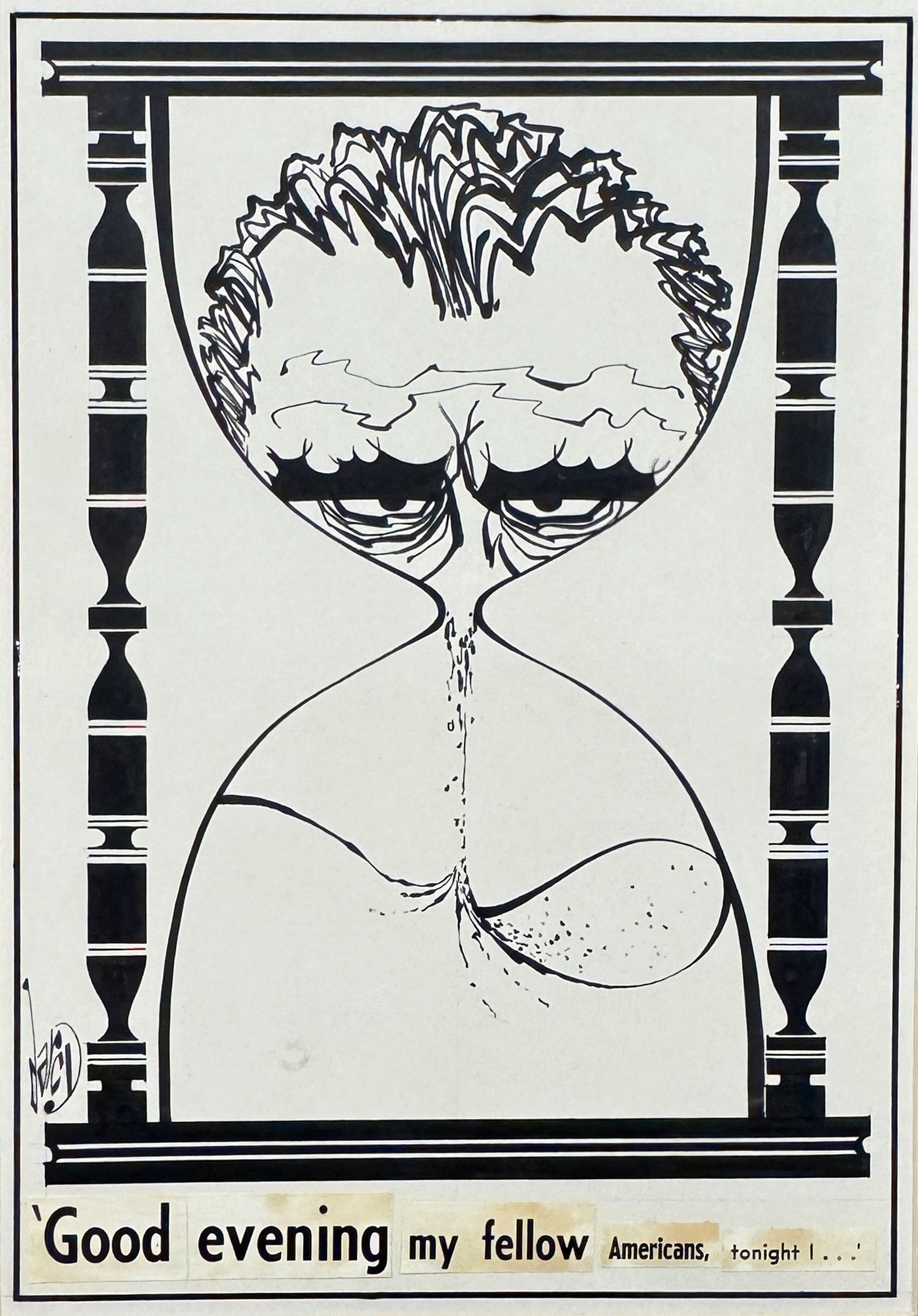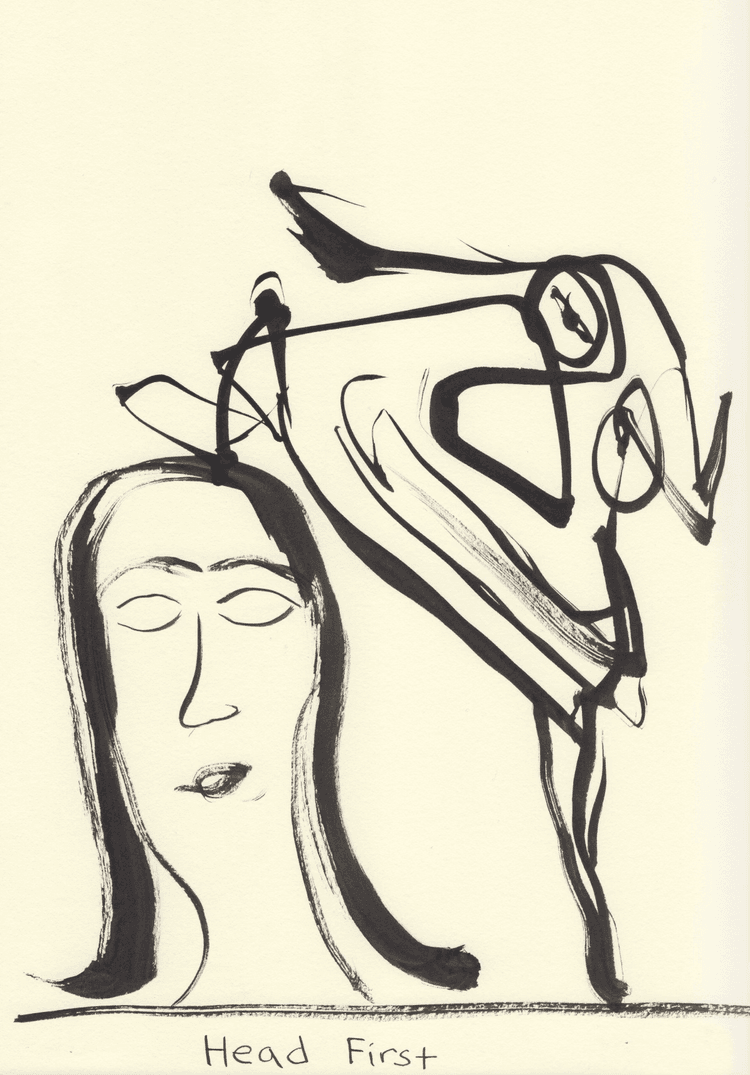Upon stepping from the street into Nunu Fine Art, 381 Broome St., one can take a stroll back in time. One experiences the 1960s to the ’80s, specifically, as seen through 120 works by the nationally-syndicated cartoonist Thomas F. Darcy.
In 1970, Darcy became Newsday’s first ever individual winner of a Pulitzer Prize, which was awarded mostly for his cartoons about the Vietnam War.
However, a full range of preoccupations and themes – racial injustice, environmental destruction, the threat of nuclear war, poverty and gun violence among them – are on display in “Darcy & Darcy: In Monochrome,” a two-person exhibition featuring the political cartoonist, who died in 2000, and the youngest of his four children, the contemporary New York-based fine artist Brad Darcy.
If the issues seem familiar enough, the exhibition recalls some news stories that have receded into the past. The viewer is invited, for instance, to reflect upon an iconic American event as its 50th anniversary approaches: the resignation of President Richard M. Nixon on Aug. 9, 1974.

A Nixon-themed cartoon by Newsday’s Tom Darcy in the Watergate era.
The president and the war were inevitably linked in some cartoons composed by the elder Darcy who was born into an Irish-American family in Brooklyn in 1932.
In his 1990 book “Newsday: A Candid History of the Respectable Tabloid,” Robert F. Keeler wrote that in the fall of 1969, “Nixon’s announcement of the withdrawal of 35,000 more troops provoked a verdict of ‘welcome, but less than comforting’ in an editorial, accompanied by a Tom Darcy cartoon showing a huge Nixon face trapped behind the White House columns, as if in a jail cell, with the caption: ‘Prisoner of War.’”
Perhaps, though, Darcy’s most famous cartoon on the subject is that which depicts a general standing beside an L-shaped coffin announcing, “Good news, we've turned the corner in Vietnam!”
The ambitious Long Island daily was to break an early Watergate story, the first that mentioned the name of G. Gordon Liddy, who’d been fired by the Committee to Reelect the President because he refused to answer questions by the FBI about the break-in at Democratic headquarters on June 17, 1972.
Everyone watched the television networks NBC, ABC and CBS, but print media, which tended to lead the way in investigative reporting, still had massive clout.
In Melville, N.Y., the printing presses of Newsday, with a daily circulation of 450,000, didn’t begin to rumble until after breakfast and the paper was delivered by young paper-carriers in the afternoon.
“Some names rang a bell,” said Brad Darcy of people mentioned in his father’s work from the era. “I had to google some others.
“It was Nunu’s idea,” he said of the exhibition and referring to the gallery owner and international art dealer Nunu Hung. “I was surprised. I didn’t see a clear way to show my work and my dad’s – they’re very different for the most part.
“She decided to put our work separately, which was a big relief,” he added. “But I think it’s put together very well. It’s museum quality.”
The younger Darcy’s work, which can be seen in the lower level, is, the gallery says, an “intimate exploration of human consciousness through automatic drawing.” By “spontaneously applying ink to paper for 20 to 40 seconds,” it continues, “he generates whimsical images documenting his multifaceted thoughts and feelings.”

Brad Darcy, “Head First,” 2017-22, ink and pencil on paper, 12 x 9 inches.
The work, the gallery says, brings a “distinct visual humor to bear on his love for nature and his fascination with what it is to be human” and that viewers can derive a “sense of peacefulness and wisdom” from it.
The artists, the gallery says, are “from different generations with markedly different personalities” but it sees them nonetheless in a “dynamic dialogue.”
The gallery’s statement suggests a commonality in “their concise portrayals, employing simple black lines on white paper to distill complex subjects to their essence.”
“It’s 20 years of my drawings, 20 years of my father’s cartoons,” said Darcy, who studied fine art and computer art at the School of Visual Arts from 1993 to 1997. “It’s a joy to go over the cartoons, and even for me to review my own work.”
He said his father was always an “inspiration” for him and a “constant creative force.”
“Growing up with a cartoonist,” he said. “It affects everything.”

Tom Darcy at work in the 1960s.
That included “pretty cool art materials” as presents at Christmas, which he said he’s “more excited” about looking back that he was at the time.
“That’s how I got started,” he said.
“We were middle-class and lived in the suburbs,” he recalled of his upbringing on Long Island. “I got the ‘Star Wars’ toys and all that junk.”
Tom Darcy was, though, in 1986, by which time Brad was in his teens, one of 50 cartoonists who protested at “war-orientated toys.” The marketing of guns to “outdoorsmen, maniacs and kids” had long been a target of the Brooklynite.
“He had empathy for the downtrodden, and was concerned with all the injustice that was going on in the world,” Brad Darcy said. “He seemed to feel a lot. You can see how passionate he was at the time, especially during the war.
“My dad had serious conversations with us at the dinner table, sometimes too serious for us, you know, growing up,” Darcy remembered. “He wanted our opinions about what was happening political, socially. Sometimes we’d chime in.”
At other times, one of his older siblings would attempt to introduce “levity or silliness” into the conversation.
“That was frustrating because my dad was a very serious guy,” he said.
Tom Darcy studied at the Cartoonists and Illustrators School, the forerunner the School of Visual Arts, and joined Newsday’s advertising department in 1956 before switching to editorial cartooning a year later. He went to the Phoenix Gazette in1959, but he was considered too liberal for the paper and moved on to others. President Johnson’s former White House Press Secretary Bill Moyers had taken over as publisher at Newsday in 1967 and brought him back to the paper. Darcy retired in 1997.
Letters from Johnson and Nixon are featured in the exhibition, with the latter presciently suggesting in 1969 that the president and the cartoonist were in their “honeymoon” period.
There are letters of appreciation, too, from Senator Ted Kennedy and Senator Thomas Eagleton, whom Darcy had sent an article he had written about his own mental-health battles.
After Moyers had left Newsday while it was being sold in 1970, Darcy contacted him. The future TV news commentator replied with a letter that said, “You are a gentle man for whom I have a deep affection as only one can have for a kindred spirit.”
“Darcy & Darcy: In Monochrome” continues through Aug. 24. Go to nunufineart.com for details.







